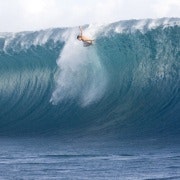Australia poised to ride a wave of success
The immense and mostly untapped power of Australia’s oceans has the potential to provide huge amounts of clean, round-the-clock energy if we can get the technology and the policy settings right. It is also a major opportunity to capitalise on our many strengths and create a high-value export industry within a decade.
Down Under the sector has had its fair share of challenges and frustrations, but the good news is that we are not alone – and there is plenty to be positive about.
Late last month I participated in a major International Energy Agency meeting in South Africa as part of an agreement between 20 countries to collaborate on ocean energy research and technology development.
The general feeling was one of optimism, as representatives from 20 member countries worked together on global actions that would promote long-term sustainability for the ocean energy sector.
The international sector has set a goal of 337 gigawatts of installed capacity by 2050, which translates to 1.2 million direct jobs across the globe and one billion tonnes of CO2 abatement. While this is obviously a long way off, governments can take a variety of steps to help us get there.
Those attending the meeting acknowledged that the development of an international technology development roadmap for ocean energy was important to galvanise action. But we also realised that there would be a lot of hard work required to ensure ocean energy is fully recognised by governments as a credible energy generation source for the future. In Australia the upcoming Energy White Paper process is a good chance for us to promote greater acknowledgement for ocean energy, which has attracted positive comments in the past from senior Coalition figures.
And, like all parts of the energy sector at the moment, ocean energy craves long-term stability and firm targets that will help unlock investment. This has so far proven elusive.
Closer to home, the CSIRO has found that the major challenges for wave and tidal power that need to be overcome include:
– The distance of Australia’s existing electricity grid from locations where ocean energy can provide the most power
– Competition with other lower-cost renewable energy technologies
– Accessing finance
– Demonstrating the environmental credentials of ocean energy.
One of the biggest challenges, as with all new forms of energy, is the ‘s’ word – support. All major parties in Australia recognise that government has a role to play in supporting early-stage technology innovation.
We have opportunities to do much of this through the Australian Renewable Energy Agency, GeoScience Australia and CSIRO, but they also need to provide firm direction and commitments.
And in order to attract finance in the first place there needs to be confidence that ocean energy technology will one day be able to make a meaningful contribution to our energy supply without the drip-feed of public funding.
Fortunately, some of the early signs for Australian innovators are extremely promising. There are almost 20 ocean energy developers currently active here working on different types of technology.
Carnegie Wave Energy has begun developing a pilot plant that will supply clean ocean energy and desalinated water to a submarine base run by the Australian Defence Department on Garden Island in Western Australia. Its CETO technology, named after a Greek sea goddess, runs beneath the waterline, meaning there are no issues with visual amenity.
Just over a week ago, Oceanlinx launched its 1-megawatt ‘greenWAVE’ energy converter in South Australia, which is made out of pre-fabricated concrete and is designed to run for 25 years of continuous operation. The company will test the unit for a year and decide whether to scale it up by a factor of 10.
There are many other emerging ocean energy technologies being developed in Australia that show immense promise. The future is bright. The CSIRO has predicted that the wave and tidal power on our doorstep could realistically provide about 10 per cent of Australia’s power by the middle of the century. And technology developed by local companies could begin to provide very real returns within 10 years if the government can set some firm targets and that will help the sector to realise its potential.
Alison Demaria is a senior policy advisor at the Clean Energy Council.
















